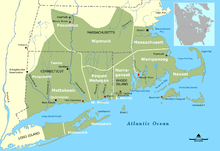
The Narragansett land claim was one of the first litigations of aboriginal title in the United States in the wake of the U.S. Supreme Court's landmark Oneida Indian Nation of New York v. County of Oneida (1974), or Oneida I, decision.[1] The Narragansett claimed a few thousand acres of land in and around Charlestown, Rhode Island, challenging a variety of early 19th century land transfers as violations of the Nonintercourse Act, suing both the state and private land owners.[2]
Judge Raymond James Pettine of the United States District Court for the District of Rhode Island granted the Narragansett's motion to strike the state's affirmative defenses and denied the state's necessary party motion and motion to dismiss. Altogether, the court rejected the state's defenses of: sovereign immunity, laches, statute of limitations/adverse possession, estoppel by sale, operation of state law, and public policy.
After the decision, Congress settled the claim with the Rhode Island Claims Settlement Act (RICSA), the first of many Indian Land Claims Settlements, extinguishing all aboriginal title in Rhode Island in exchange for $3.5 million.[2] The Narragansett claim was "the first of the eastern land claims to be settled."[3] The Narragansett received federal recognition in 1983 and have unsuccessfully attempted to establish a Native American gaming enterprise.
- ^ Oneida Indian Nation of N.Y. v. County of Oneida (Oneida I), 414 U.S. 661 (1974).
- ^ a b Jarboe, 2010, at 407 n.72.
- ^ Vecsey & Starna, 1988, at 26.